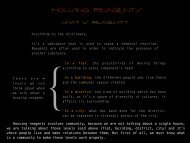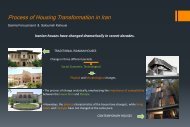Housing Concepts - Oikodomos
Housing Concepts - Oikodomos
Housing Concepts - Oikodomos
Create successful ePaper yourself
Turn your PDF publications into a flip-book with our unique Google optimized e-Paper software.
OIKODOMOS <strong>Housing</strong> <strong>Concepts</strong><br />
PATTERN<br />
<strong>Housing</strong> conveys repetition and variation over time, at different scales (town,<br />
building, and house) and periods (a lifetime, a generation, etc.). A housing<br />
type, repeated throughout different generations, gives rise to a town structure.<br />
The repetition is not just duplication, because it also conveys an adaptation to<br />
changing needs. Over the centuries, vernacular housing has proceeded in this<br />
way: maintaining a particular way of building throughout time, “a timeless way<br />
of building”, using the expression of Christopher Alexander (1977).<br />
Alexander gave the term “pattern” to the archetype, which in itself contains a<br />
set of rules -- deeply embodied in the unconsciousness of people -- to be<br />
reproduced throughout time. Because the rules are understood by the inhabitants,<br />
the process of repetition and adaptation can be applied to the design and<br />
construction of the built environment generation after generation, thereby<br />
determining a particular way of living and building that characterizes a culture.<br />
According to Alexander, “Each pattern describes a problem which occurs over and<br />
over again in our environment, and then describes the core of the solution to<br />
that problem, in such a way that you can use this solution a million times over,<br />
without ever doing it the same way twice” (Alexander, 1979). The rules embedded<br />
in a pattern describe both the problem and the solution to the problem.<br />
These rules can be of different kinds: social, insofar as there is a pattern in<br />
the way inhabitants interact among themselves and with the built environment;<br />
design, which determines the arrangement of spaces and formal languages; and<br />
constructive, which guides the process of construction. All of them are<br />
interwoven in the pattern. A pattern embodies both the formal -- at the building<br />
and neighbourhood levels -- and anthropological characteristics of a particular<br />
culture materialised in the built environment.<br />
The idea of a form, a language that serves as<br />
communication between designed objects (including<br />
buildings) and users, can also be found in the work<br />
and texts of Allison and Peter Smithson.<br />
The notion of a form-language, expressed in the<br />
article Signs of Occupancy, 1972, bears a resemblance<br />
to Alexander’s pattern language.<br />
An ideal house should<br />
not only respond to the<br />
objective properties of<br />
a building spatial<br />
arrangement, activities<br />
and structure but<br />
should also leave the<br />
dweller space for<br />
interpretation:<br />
“The ideal house is<br />
that which one can make<br />
one’s own without<br />
altering anything.<br />
Make one’s own in the<br />
usual way that is<br />
within the limits of<br />
the fashion of the<br />
time, and without<br />
feeling any pressure<br />
either to communicate<br />
one’s trivial<br />
uniqueness or to<br />
absurdly conform”.






